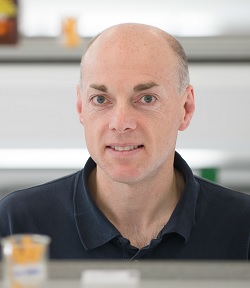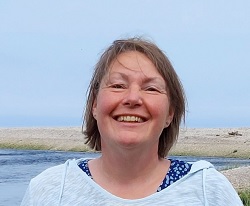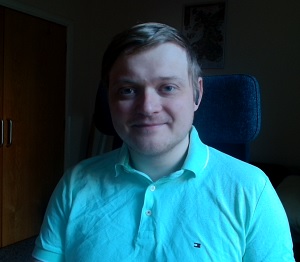Who's Who
Published: 31 March 2022
Profiles of current staff, why they came to Glasgow and what their plans are
Professor Andrew Sutherland, School of Chemistry
 What is your academic history? I obtained a BSc degree in chemistry from the University of Edinburgh (1994) and a PhD in chemistry from the University of Bristol (1997). After 3 years as an Alberta Heritage Foundation Medical Fellow at the University of Alberta (1998-2001), I rejoined the University of Bristol as a research fellow. In 2003, I began my career at the University of Glasgow as a lecturer in Chemistry. I was promoted to Senior Lecturer in 2008, Reader in 2016 and Professor of Organic Chemistry in 2020. I am currently Director of Research, Deputy Head of School and the Head of the Chemical Biology and Synthesis Section.
What is your academic history? I obtained a BSc degree in chemistry from the University of Edinburgh (1994) and a PhD in chemistry from the University of Bristol (1997). After 3 years as an Alberta Heritage Foundation Medical Fellow at the University of Alberta (1998-2001), I rejoined the University of Bristol as a research fellow. In 2003, I began my career at the University of Glasgow as a lecturer in Chemistry. I was promoted to Senior Lecturer in 2008, Reader in 2016 and Professor of Organic Chemistry in 2020. I am currently Director of Research, Deputy Head of School and the Head of the Chemical Biology and Synthesis Section.
When did you join the University of Glasgow? January 2003.
Why did you choose to come to the University? While looking for academic jobs at the end of my time as a research fellow, a position in organic chemistry was advertised at the University of Glasgow. Chemistry had just made a whole series of new appointments (Hargreaves, Cronin, Lapthorn, Price, Murrie and Parker) and so it was an exciting time to join the department and the University. It was also nice to return to Scotland after nine years away.
What research are you currently working on? My research group work on two main research themes both focused on molecular imaging. Our main research programme is the development of radionuclide based medical imaging agents for disease. We have developed PET and SPECT tracers that can detect brain tumours and diagnose inflammation associated diseases such as stroke and myocardial infarction. We are also interested in the development of new fluorescent amino acids and peptides that can be used as probes for chemical biology applications. We also develop new organic reactions using transition metal catalysts, which underpins our imaging projects.
What do you hope to achieve at the University? My hope is that the medical imaging agents we develop can find widespread use for the diagnosis and treatment of disease and, that the sustainable synthetic chemistry we develop can be used by other research groups and industry to make important compounds such as pharmaceuticals. I also hope that the training and experience gained by undergraduate and postgraduate researchers in the group helps produce successive generations of scientists.
What are your impressions about Glasgow as a city? I really enjoy living in Glasgow. The people are friendly and it is a great city for concerts and sports. I am a member of the Maryhill Harriers and running is a great way to see the city and surrounding countryside.
What Impact & Knowledge Exchange activities are you currently working on &/or plan to develop? The main impact of our research has been the development of medical imaging agents for cancer and neurological diseases. One of our PET imaging agents that can detect and diagnose inflammation associated diseases in the brain (stroke and MS) and the cardiovascular system has passed all early trials and is about to start first in human studies. If successful, this compound could be used to diagnose a range of diseases and help with drug discovery.
Dr Claire Wilson, Experimental Officer (Research) School of Chemistry
 I joined the University of Glasgow in December 2014, as an experimental officer in the School of Chemistry running the X-ray diffraction facilities. I moved from Diamond Light Source in Oxfordshire where I had been working with a very broad user-base as part of the National Crystallography service. Before that I worked within industry as an application scientist, at the University of Nottingham and as a postdoc in Århus, Denmark after completing my doctorate (in crystallography) at the University of Durham and the Institut Laue Langevin in Grenoble, France.
I joined the University of Glasgow in December 2014, as an experimental officer in the School of Chemistry running the X-ray diffraction facilities. I moved from Diamond Light Source in Oxfordshire where I had been working with a very broad user-base as part of the National Crystallography service. Before that I worked within industry as an application scientist, at the University of Nottingham and as a postdoc in Århus, Denmark after completing my doctorate (in crystallography) at the University of Durham and the Institut Laue Langevin in Grenoble, France.
My current role in the University involves providing an analytical service to researchers and external users. Depending on the nature of the project, I may collect and analyse data on behalf of users, or train and support colleagues and other researchers to do this themselves. In recent months, I've assisted colleagues from across College to analyse samples from energy materials, catalysts, supramolecular gels and rocks. We have a new diffractometer and we are always happy to discuss new projects. More recently, I have been involved in setting up the College Analytical Suite, which aims to provide a range of analytical tools and expertise to existing and new users.
I’m excited to have very recently been appointed to the EPSRC Strategic Advisory Team for capital infrastructure as a research technical professional. I look forward to providing an RTP perspective that informs national policy. I also play an active role in the British Crystallographic Association and have enjoyed teaching crystallography to postgraduate students from across the UK and elsewhere on the BCA Chemical Crystallography Group’s Intensive Teaching School.
Outside of work, I really enjoy living in Glasgow, both for being in the city and, as a keen hillwalker, the easy access to spectacular hills.
Dr Steffan Gwyn, Research Development Officer
 When did you join the University of Glasgow? I joined the University initially as a PhD student for Prof. Tony Kelly in the CDT for Photonic Integration and Advanced Data Storage in 2016. I started working as an External Engagement Officer in the School of Physics and Astronomy last March and have since moved into a role in the Researcher Development and Knowledge Exchange team in CoSE.
When did you join the University of Glasgow? I joined the University initially as a PhD student for Prof. Tony Kelly in the CDT for Photonic Integration and Advanced Data Storage in 2016. I started working as an External Engagement Officer in the School of Physics and Astronomy last March and have since moved into a role in the Researcher Development and Knowledge Exchange team in CoSE.
Why did you choose to come to the University? Throughout my PhD, I was always interested in the applications my research would have in the real world and following on from my studies I found myself wanting to move into a role which enabled me to support research and development with the softer skills I’d gained. I’d enjoyed being part of the University family as a student, and when a role that was essentially what I wanted to do was made available, I didn’t think twice about going for it!
Describe your role in the University. I work partly within the team that helps deliver the EPSRC Impact Acceleration Accounts as a Knowledge Exchange Associate, focusing on Photonics, and partly as a Research Development Officer. My role is extremely varied, with duties such as supporting academics with grant and fellowship applications, developing industrial links for researchers to form collaborations, reviewing IAA proposals, and working on expanding on some research themes, where there are capabilities college-wide that have a range of applications within a specific sector. Currently, we’re developing the Space Glasgow Network, including digital content for online use, and expanding the network to cover research in Earth observation and satellite communications.
What are you most proud of achieving at the University? Last summer I wrote the University’s successful application to become an Associate Member of SPRINT, the SPace Research and Innovation Network for Technology, which has given us a springboard to further develop our research within the space sector and provide access for our academics to a network of SMEs and Universities to collaborate with.
How has the University changed since you joined? As I’ve only been working in the University for a year, and the vast majority of it working from home, it’s hard to say how the University has changed in the time I’ve been here! I’m looking forward to getting back to the office and meeting colleagues face-to-face and continue supporting our amazing research.
How would you sum up the University in five words? An inspiring, world-leading community.
In this edition:
Welcome from Professor Muffy Calder
Research, Impact & Knowledge Exchange
News Roundup across the College
First published: 31 March 2022
<< April 2022

